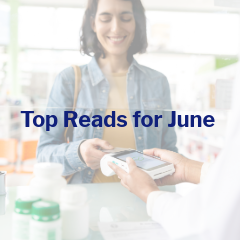
The top three Prescribed Perspectives articles downloaded by health systems in June.
How Utilization Optimization can help health systems identify cost saving and revenue opportunities.
By
Date
April 24, 2023

Read time: 5 minutes
By: McKesson Editorial Team
Adrienne Donaldson, RPh., MSLIT Director, McKesson Business Intelligence has more than 20 years of experience in retail pharmacy operations, technology, and program management helping pharmacies maximize their utilization of pharmacy practice resource tools, including implementation, training, and ongoing analytics support for effective and efficient use of McKesson Spend Analytics and Utilization Analytics programs to quantify the economic impact of drugs/medication for their organization.
Q: How is the business of health system pharmacy changing?
A: The future of health system pharmacy has become more diverse. There has been a shift from solely focusing on inpatient care and controlling drug expenditures to health systems now looking to include retail and specialty operations, as well as the expansion beyond the hospital walls with oncology clinics, and hospital-owned infusion centers. This growth helps patients flow through the continuum of care while also providing health systems with revenue opportunities.
Along with this comes greater complexity. Pharmacies had previously been measured and held to a drug spend or expense budget. Historically, the primary thought was “How can I save money?” While controlling expenses is still required, it is no longer the primary focus of pharmacy business. The most expensive drug option may have better patient outcomes and may ultimately be most profitable. With new areas of business, a different and more complete clinical and financial analysis is required to determine profitability and best business practice, which includes an understanding of value-based care drugs across the spectrum.
Q: How can health systems maintain profitability?
A: Without a view across business lines, it is difficult to maintain a profitable health system pharmacy business. Understanding patterns in payer reimbursements and how to optimize drug procurement is critical to maximizing margins. Pharmacies also need to understand and analyze profit and loss reporting to identify the most profitable drug or alternative therapy within a biosimilar grouping or diagnostic class (Rheumatoid Arthritis, Ulcerative Colitis, Crohn’s, etc). With this level of data, a multidisciplinary team including supply chain, clinical pharmacy, revenue cycle, and finance have greater line of sight into how their specific area can impact the business and the rationale behind key decisions.
Q: How can McKesson’s Utilization Analytics connect purchasing, usage data, and reimbursement date to maximize cost savings and revenue opportunities?
A: McKesson’s UA tool provides accurate utilization costs based on purchases, rather than charges, to correlate contract pricing and payments while identifying cost-saving and revenue improving opportunities.
The platform offers self-service reporting and visualization capabilities, as well as pharmacist and analyst assisted oversight. It integrates purchasing, usage, and reimbursement data to determine utilization costs by diagnosis and drug. Our expert support team is there to assess actual drug dispensation data to help you identify opportunities, create custom reports, and assist with budget impact. In addition, there are customized output of white bag, PAP, and free drug reports, as well as a biosimilar report.
The UA tool also provides seamless integration with existing McKesson solutions and services including ERA and Revenue Recovery, helping your health system to achieve more while enhancing visibility into the financial performance of your pharmacy.
Expect more from your distributor. Achieve more with McKesson.